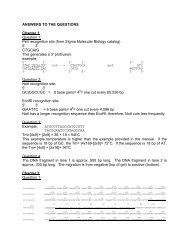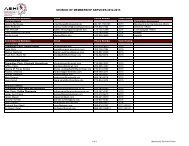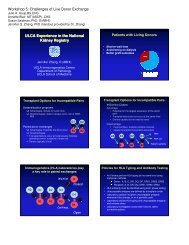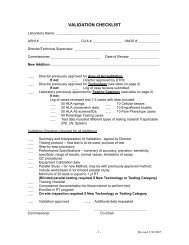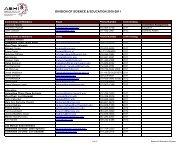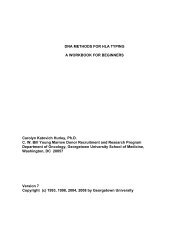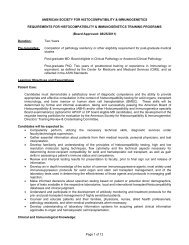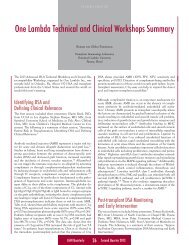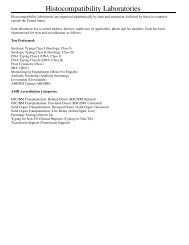Monday, September 27, 2010 2:00 PM - American Society for ...
Monday, September 27, 2010 2:00 PM - American Society for ...
Monday, September 27, 2010 2:00 PM - American Society for ...
- No tags were found...
You also want an ePaper? Increase the reach of your titles
YUMPU automatically turns print PDFs into web optimized ePapers that Google loves.
Methods: For this purpose, we accessed the effect of G-CSF on the phenotype, cytokine secretion profileand cytotoxicity of NK cells incubated in vitro <strong>for</strong> 48h in presence of G-CSF as well as of NK cells isolatedfrom peripheral blood of G-CSF mobilised stem cell donors (in vivo).Results: In vitro, G-CSF caused a strongly altered phenotype in NK cells with 49% downregulation ofNKp44 frequency. Furthermore, the expression of the activating receptors NKp46 and NKG2D decreased40% and 64%, respectively. The expression of two inhibitory receptors, KIR2DL1 and KIR2DL2,decreased by 46% each. In cytotoxicity assays, the lytic capacity of G-CSF exposed NK cells againstallogeneic target cells is reduced by up to 68% in vitro and up to 83% in vivo. Accordingly, the levels ofgranzyme B of in vivo G-CSF-exposed NK cells were reduced by up to 87% in comparison to nonstimulatedNK cells. Cytokine production of in vitro and in vivo incubated NK cells was strongly decreased<strong>for</strong> IFN-gamma, TNF-alpha, GM-CSF as well as IL-6 and IL-8. Furthermore, we observed a reduction inproliferation and a positive feedback loop that increased the expression of the G-CSF receptor (G-CSFR3).Conclusions: In conclusion, G-CSF demonstrated to be a strong inhibitor of NK cells activity and mayprevent GVL effect post-transplantation.19-ORPHENOTYPING STUDY OF KIR EXPRESSION ON NK AND NKT CELLS.Mei Han 1 , Lin Fan 2 , Lama Hussein 2 , Peter Stastny 1,2 . 1 Internal Medicine - Transplant Immunology, UTSouthwestern Medical Center, Dallas, TX, USA; 2 Pathology, UT Southwestern Medical Center, Dallas, TX,USA.Aim: The function of NK cells is regulated in large part by the interaction of inhibitory receptors and theirHLA ligands. Expression of KIR on the cell surface is clonally regulated and the frequency of NK cellsexpressing single or multiple KIR may vary from person to person. Using multicolor flow cytometry it ispossible to analyze the expression of KIR and NKG2A on the surface of single cells and to obtain robustphenotypic data.Methods: We have analyzed NK cells by flow cytometry from 19 Caucasoids and 18 Asians and stainedthem <strong>for</strong> CD3, CD56, KIR2DL1, KIR2DL2/L3, KIR3DL1, and NKG2A. The KIR expression pattern wasanalyzed on gated CD3 - CD56 + NK cells as well as CD3 + CD56 + NKT cells using a 6-color flow cytometer.Each person was also genotyped <strong>for</strong> KIR and HLA class I by PCR-SSP.Results: Widely different frequencies were observed. One KIR could be found in 8% of NK cells, anotherKIR in 90% of NK cells in the same person. Differences of this magnitude were also observed betweenindividuals. NK cells expressing KIR2DL1 ranged from 8% to 46%, KIR2DL2/L3 from 21% to 91% andKIR3DL1 from 6% to 77% of NK cells. The expression of KIR2DL2/L3 was more frequent in Asians thanin Caucasoids (p



